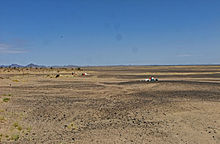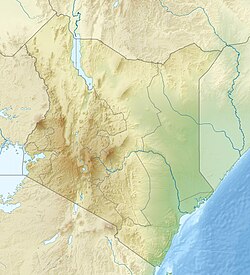 The site of Nataruk taken during excavations | |
| Location | Turkana County, Kenya |
|---|---|
| Region | Lake Turkana |
| Site notes | |
| Discovered | 2012 |
| Excavation dates | from 2012 |
| Archaeologists | Marta Mirazón Lahr |
| Dated to 9,500–10,500 BP (7,550–8,550 BC) | |
| History of Kenya |
|---|
 |
|
|
Nataruk in Turkana County, Kenya, is the site of an archaeological investigation which uncovered the remains of 27 people.[1][2] It dates between 9,500 and 10,500 BP (7,550–8,550 BC).[3] The remains have garnered wide media attention for possible bioarchaeological evidence of interpersonal violence, i.e. prehistoric warfare.
According to the Nature article published by Dr. Mirazón Lahr and colleagues, the skeletons present the earliest evidence for intergroup violence among hunting-foraging populations, which they interpret as a "massacre":[2] the remains of adults and six children show signs of a violent end, having been clubbed or stabbed and left to die without burial.[1][4] Two of the male remains had stone projectile tips lodged in the skull and thorax.[4]
However, a 'Brief Communication Arising' published in Nature by Christopher Stojanowski and colleagues calls into question much of the alleged evidence of a "massacre".[5] Their critique centers on two main points. First, these authors suggest that much of the evidence of peri-mortem trauma identified by Mirazón Lahr is equally - if not more - likely to have occurred after deposition; that is, after the skeletons were buried, intentionally or otherwise. Second, Stojanowski disagrees over the interpretation of the site formation processes. Where Mirazón Lahr sees little evidence for intentional burial at the site, Stojanowski argues that the bodies at Nataruk are mostly articulated, spatially organized, non-commingled, and preserve limited variation in body positioning, all of which are inconsistent with skeletons from well-documented massacre sites.[5][6]2°42′24″N 36°08′31″E / 2.70661°N 36.14191°E
It is unclear exactly what happened at the site, but Mirazón Lahr stands by her interpretation that it was a massacre, the result of an attack by another group of hunter-gatherers.[1][7] They stated it is "the earliest scientifically-dated historical evidence of human conflict."[4], although Jebel Sahaba, another prehistoric massacre site, has been dated between 13,400 and 18,600 BP and predates Nataruk by several millennia.[8]
The excavation at Nataruk, led by Dr. Marta Mirazón Lahr as part of the IN-AFRICA Project,[9] began in 2012.[1]
- ^ a b c d "Ancient 'massacre' unearthed near Lake Turkana, Kenya - BBC News". BBC Online. Retrieved 21 January 2016.
- ^ a b Lahr, M. Mirazón; Rivera, F.; Power, R. K.; Mounier, A.; Copsey, B.; Crivellaro, F.; Edung, J. E.; Fernandez, J. M. Maillo; Kiarie, C.; Lawrence, J.; Leakey, A.; Mbua, E.; Miller, H.; Muigai, A.; Mukhongo, D. M.; Van Baelen, A.; Wood, R.; Schwenninger, J.-L.; Grün, R.; Achyuthan, H.; Wilshaw, A.; Foley, R. A. (2016). "Inter-group violence among early Holocene hunter-gatherers of West Turkana, Kenya". Nature. 529 (7586): 394–398. Bibcode:2016Natur.529..394L. doi:10.1038/nature16477. PMID 26791728. S2CID 4462435.
- ^ https://go.gale.com/ps/i.do?id=GALE%7CA440918913&sid=googleScholar&v=2.1&it=r&linkaccess=abs&issn=00280836&p=AONE&sw=w&userGroupName=anon%7E7a253b04
- ^ a b c "Evidence of a prehistoric massacre extends the history of warfare". University of Cambridge. 2016-01-20. Retrieved 21 January 2016.
- ^ a b Stojanowski, Christopher M.; Seidel, Andrew C.; Fulginiti, Laura C.; Johnson, Kent M.; Buikstra, Jane E. (2016). "Contesting the massacre at Nataruk". Nature. 539 (7630): E8–E10. doi:10.1038/nature19778. PMID 27882979. S2CID 205250945.
- ^ Meyer, Christian; Lohr, Christian; Gronenborn, Detlef; Alt, Kurt W. (2015-09-08). "The massacre mass grave of Schöneck-Kilianstädten reveals new insights into collective violence in Early Neolithic Central Europe". Proceedings of the National Academy of Sciences. 112 (36): 11217–11222. Bibcode:2015PNAS..11211217M. doi:10.1073/pnas.1504365112. ISSN 0027-8424. PMC 4568710. PMID 26283359.
- ^ Lahr, M. Mirazón; Rivera, F.; Power, R. K.; Mounier, A.; Copsey, B.; Crivellaro, F.; Edung, J. E.; Fernandez, J. M. Maillo; Kiarie, C. (2016). "Mirazón Lahr et al. reply". Nature. 539 (7630): E10–E11. doi:10.1038/nature19779. PMID 27882957. S2CID 4394176.
- ^ Crevecoeur, Isabelle; Dias-Meirinho, Marie-Hélène; Zazzo, Antoine; Antoine, Daniel; Bon, François (2021-05-27). "New insights on interpersonal violence in the Late Pleistocene based on the Nile valley cemetery of Jebel Sahaba". Scientific Reports. 11 (1): 9991. doi:10.1038/s41598-021-89386-y. ISSN 2045-2322.
- ^ "IN-AFRICA Project". In Africa: The role of East Africa in the evolution of human diversity.
© MMXXIII Rich X Search. We shall prevail. All rights reserved. Rich X Search

